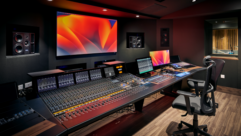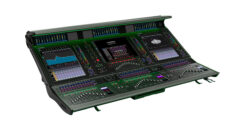Creating Dynamic Virtual Spaces
As innovation races ahead at light speeds, there is a dire need for all of us to make a critical design analysis and construct a new design architecture for interacting with the artificial spaces we are creating. By fusing architectural design with inspiring space and flow management, we can bring together the lessons of high-end AV techniques, virtual reality, and supercomputing collaborations to create remote presence in virtual environments.
AS INNOVATION RACES AHEAD AT LIGHT SPEEDS, THERE is a dire need for all of us to make a critical design analysis and construct a new design architecture for interacting with the artificial spaces we are creating. By fusing architectural design with inspiring space and flow management, we can bring together the lessons of high-end AV techniques, virtual reality, and supercomputing collaborations to create remote presence in virtual environments.WHICH SPACE CHANGES?An argument could be made that our work practices must change towards the use of these new systems. Conversely, a better approach may be to design systems to more closely match our working behavior. The first is simply a way to accept the current infantile state of design of virtual environment systems. As applications become more sophisticated, the requirement for fully immersive virtual environments will grow.
Though our focus may be tightly held by the grandeur of virtual spaces, we should not ignore the reality within which these environments exist. The “real space” and its efficient functionality play a critical role in the success of the utilization of virtual environments and ultimately the creation of virtual presence.
A virtual reality display system by itself is not enough. Currently, there are many products available commercially that allow users to have fully immersive virtual experience. These systems are fully engaging once we enter into their environment; however, they are not conducive to the workspace practices that most people are used to.
Credit: NCSA/University of Illinois Urbana-Champaign
But, there are other ways to construct spaces, which allow for virtual reality immersion plus the accommodation of non-stereoscopic AV environments for the manipulation of data, distance collaboration, and interaction through HD video-conferencing and resource systems control. The latest trend is creating “telecubicals.” Still, these efforts are technically oriented, focusing solely on the immediate display area. We need to broaden our scope towards an overall architectural design methodology that satisfies multiple programmatic functions with an emphasis on the actual use of the physical space.
Advanced AV systems have been a significant part of the corporate culture for many years. Videoconferencing and presentation rooms are the crown jewel of technology for most major corporations. However, as costs dropped, they have become more available as viable options for research, academic, and government applications. These AV systems, coupled with advanced supercomputing techniques and broad bandwidth networking applications, create a wonderful opportunity for a dynamically rich virtual environment to explore data and collaborate with remote participants. With the addition of projection-based virtual reality environments, the potential to construct environments to handle a wide variety of disciplines is really exciting.
Architecture is the fundamental discipline to link all of these components together. By using architectural methodologies to create a process where each of the required components is synthesized, a complete unified design can be created. A lead architect can meet individually with these disparate groups and incorporate their needs into a master plan. He will also be able to guide the design plan through the rigors of build-out and construction phases.
However, developing spaces for virtual environments is a very new concept. Architects will need to learn how to communicate and work with people from very different cultures, and they’ll also need to think in terms of traffic flow and how groups of people interact with these environments. Furthermore, architects will need to carefully balance the need of technical functionality and how it impacts form.
Creating Dynamic Virtual Spaces
As innovation races ahead at light speeds, there is a dire need for all of us to make a critical design analysis and construct a new design architecture for interacting with the artificial spaces we are creating. By fusing architectural design with inspiring space and flow management, we can bring together the lessons of high-end AV techniques, virtual reality, and supercomputing collaborations to create remote presence in virtual environments.
CASE STUDY
An example of a designed physical space for working within virtual environments and advanced collaborative models is the National Center for Supercomputing Applications (NCSA) ACCESS facility in Arlington, Va. The facility is designed in a modular fashion where each individual studio can be considered as a stand-alone “center,” or the collection of spaces can be taken together as a complete and functioning whole. An advanced AV capability is designed throughout, allowing for the easy manipulation of video, audio, and data across the various spaces.
It’s also important to consider the ability to broadcast from high-end systems to lower noninteractive levels of visualization and information interfaces. An advanced AV infrastructure can help facilitate these multiple types of needs. There are three main areas that comprise the majority of the spaces at NCSA ACCESS. A demonstration area, which can seat up to 50 people, utilizes multiple projections and an “ImmersaDesk” virtual reality display system. The Access Grid is a technology that is frequently used to manage the many meetings in the demonstration area. A conference room, which can seat from 6 to 20 people, also incorporates the use of multiple projectors and the Access Grid. In the conference room, the Access Grid operator is removed from the room. This is an example of how remote operations could be used to facilitate meetings and manage resources.
The third main space is a training area, which can handle 20 workstations. Surrounding these main areas are collaboration studios for small-scale meetings or breakout rooms and can also be used for individual demonstrations. There are also office spaces for managing facility operations. The facility is directly connected by gigabit Ethernet into the Mid-Atlantic Crossroads gigaPOP (gigabit point of presence), which in turn connects NCSA ACCESS into the National Lambda Rail, Internet2, and other broad bandwidth network infrastructures. NCSA ACCESS acts as a portal into these networks —which includes not only the physical connectivity to an international scientific grid of resources, but, more important, to the researchers and scientists involved with using those resources.
The components for creating a dynamic physical space for enabling virtual environments lay all around us. It requires an open-minded architect with technical knowledge who can liaison and enable the many disciplines involved with virtual environments. The goal is to develop a design, which can efficiently incorporate all the needs and functions demanded by such an environment.
Virtual environments demand the synthesis of multiple technical professions into a functional real physical space. By using an architectural methodology as a binding mechanism, a comprehensive design can be developed and the end goal of creating virtual presence can be achieved.
Tom Coffin is the technical coordinator at the NCSA ACCESS facility in Arlington, Va. He can be reached at [email protected].










